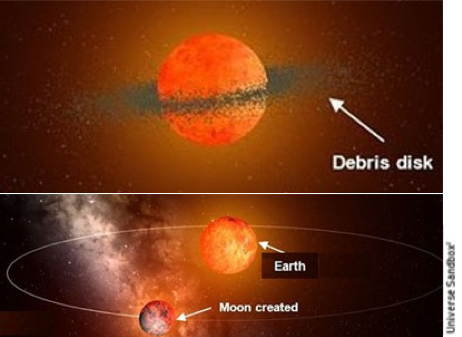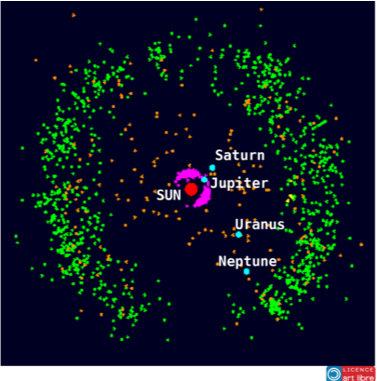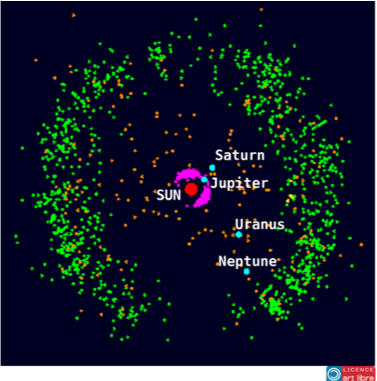Then Purana Became the Source of all the Sciences…
Padma Purana, Section I, Ch. 1, v. 50
The Puranic Universe: The Sanskrit word purana means ancient. To associate the word with anything modern may at first seem incongruous. To suggest that the ancient Hindu texts, the Puranas, have anything in common with modern science will appear incredible to most. And yet, that is what a nuanced reading of the Puranas suggests.
The Puranas are one of the three widely known sets of texts in the Hindu faith, along with the Vedas and the Itihasas. Vedic hymns are recited at significant events in a person’s life cycle–such as naming ceremony, marriage and others. The Itihasas are considered history, a record of what happened. The authors of the two Itihasas, Maharishi Vyasa and Valmiki, were not just alive during the time of the epics but were themselves a part of the narrative. The Itihasas have been translated, abridged, widely read and analyzed. The Puranas, however, have not attracted as much attention. For the most part, they have been mined for their amazing stories and their dharmic and cultural symbolisms.
My reading of the Puranic texts began with the Matsya Purana. I wasn’t sure of what to expect, probably a collection of stories about the various divinities. The Matsya Purana turned out to be of a text of great sophistication and kept me so engrossed that I went on to study the Shiva and the Bhagavata Puranas as well.
It was hard to find the translations of the other Puranas, so I had to download and print scanned PDFs of old publications to continue my journey. As I read on, it became apparent that the Puranas were more than just a collection of charming stories. I have had a fascination with the space sciences and cosmology since my days at school. The resonance of these stories with current science was becoming increasingly difficult to explain away as just happenstance.
On the Lifecycle of Sun: A significant set of stories in the Puranic texts relates to the sun. The lifecycle of a star such as our sun, as understood by science, consists of five stages. They are birth, wild youth (yes, even stars do have them), the current mature stage, the Red Giant stage and finally, death as a White Dwarf.
 The first two stages are described allegorically, through stories. The story of the birth is that of the Sun God Martanda, born of Sage Kashyap and Aditi. The juvenile stage of the star and its subsequent maturity are appropriately described through the marriage of the Sun God, here named Vivasvan, with Samjna. Each of these can be read as charming tales, but the details presented and our current knowledge of the sun’s lifecycle make the allegory obvious.
The first two stages are described allegorically, through stories. The story of the birth is that of the Sun God Martanda, born of Sage Kashyap and Aditi. The juvenile stage of the star and its subsequent maturity are appropriately described through the marriage of the Sun God, here named Vivasvan, with Samjna. Each of these can be read as charming tales, but the details presented and our current knowledge of the sun’s lifecycle make the allegory obvious.
The last two stages of the Red Giant and the White Dwarf are straight out descriptions in the Puranas. The implications of a Red Giant Sun for our planet is currently an area of investigation for science. For this to be discussed in eye-watering detail in a text of this antiquity is staggering.
 Let us take the example of the Red Giant stage of the Sun. Scientists today hold forth that the sun will enter this stage in about 5 billion years and could grow up to 100 times its current size. Current models suggest that the sun’s orb is likely to envelop Mercury and Venus and come close to the earth, making the planet earth extremely hot. The adjacent image (source: phys.org) is an artist’s impression of the Red Giant sun close to the planet Earth.
Let us take the example of the Red Giant stage of the Sun. Scientists today hold forth that the sun will enter this stage in about 5 billion years and could grow up to 100 times its current size. Current models suggest that the sun’s orb is likely to envelop Mercury and Venus and come close to the earth, making the planet earth extremely hot. The adjacent image (source: phys.org) is an artist’s impression of the Red Giant sun close to the planet Earth.
The Puranas term the sun in this stage as the Samvartakaditya, the ‘sun that destroys the world.’ The Brahmanda Purana’s description of the sun heating the earth starts with the planet experiencing a severe drought. As a result of this, many of the animals and plants die and are turned to dust.
133-136a. On account of it, only those living beings deficient in strength or having very little potentiality on the surface of the earth become dissolved and get mingled with the dust.
As this Sun grows in size, it gets closer to the earth, further heating it. Due to the heat, the water in the oceans turns to vapor.
136b -140. Seven rays of the sun that blazes in the sky sucking up water, drink water from the great ocean.
Heated by the Sun, the earth slowly becomes a blazing red ball, similar to the artist's impression in the image above.
157b-159. Getting the fiery splendour transmitted to it, the entire universe slowly assumes the form of a huge block of iron and shines thus. (Brahmanda Purana, Book III, Section iv, Ch. 1)
The verses above are a sample from an extensive passage in the Brahmanda Purana. The level of detail in the text is astounding.
Following this, we have the Sun collapsing to become a White Dwarf. It leads to torrential rains and the submergence of the planet in Ekarnava, the one vast ocean.
The Story of the Moon: The Puranas similarly have many references to the Moon. Many of us may recall the story of the Moon, having 27 wives.
21. Daksa, the son of Pracetas, gave in marriage to the Moon the twenty-seven Daksayanis (daughters of Daksa) of great holy rites, whom they know as the stars. (Brahmanda Purana, Book II, Section iii, Ch. 65)
The path of the Moon’s orbit around the Earth is divided into 27 equal parts in the Indian Nakshatra system. The lunar month is 27.3 days, and 27 is the nearest whole number. The Moon is seen every dawn next to a new nakshatra. This is taken to mean it had spent the night with that nakshatra, with that wife! Hence the story of the moon having 27 wives, the 27 nakshatra.
 The scientific view is that the Moon originated from the impact of a smaller Mars-sized planet with the earth. This is called the Giant Impact hypothesis. The cataclysmic collision resulted in a large cloud of debris that orbited the earth. Over time, the dust in this cloud clumped together to form the moon. The adjacent illustrations (source: OpenLearn) are a simulation of the last two stages of this event. This is a field of study that is not considered settled, and this hypothesis has a few variants.
The scientific view is that the Moon originated from the impact of a smaller Mars-sized planet with the earth. This is called the Giant Impact hypothesis. The cataclysmic collision resulted in a large cloud of debris that orbited the earth. Over time, the dust in this cloud clumped together to form the moon. The adjacent illustrations (source: OpenLearn) are a simulation of the last two stages of this event. This is a field of study that is not considered settled, and this hypothesis has a few variants.
 In this Puranic story, the Moon spends all his time with Rohini, ignoring his other 26 wives, Rohini’s sisters. Daksha, the moon’s father-in-law, curses him to waste away by consumption, for not treating all his daughters equally!
In this Puranic story, the Moon spends all his time with Rohini, ignoring his other 26 wives, Rohini’s sisters. Daksha, the moon’s father-in-law, curses him to waste away by consumption, for not treating all his daughters equally!
A Moon that is always in one place in the sky (close to one star) is a Moon headed towards the earth. The debris of the resulting collision spreads in a region of space called the Kshiroda Sagara. This region of space is ‘churned’ to make the Moon manifest again. This is a complex story and is explained in some detail in a new book, I have just published.
The book is titled ‘From the Beginning of Time.’ It examines the universe of the Puranas in five parts. These are the Sun, the Moon, the Earth, the Bhumandala and the Lokas (Deva and Patala loka). The descriptions of the five parts create a collage of the Puranic universe. The story of the descent of the Ganga links to these narratives and demonstrates that they are not just disparate accounts.
The Extraterrestrial Origins of Ganga: The Ganga is not just the river that is much revered in India. The story of its descent to the Earth is really the story of the extraterrestrial origin of the Earth’s waters, as understood by modern science. The models describing the early Earth suggest it would have been too hot to hold liquid water on its surface.
The Ganga is described in the Bhagavata Purana as descending from the heavens and covering the Brahmanda.
1. Through that opening, rushed in the stream of waters, covering externally the cosmic egg. (Bhagavata Purana, Book V, Ch. 17)
The Puranas also have the well-known story of the Ganga being brought down from the heavens as a result of King Bhagirath’s penance. The waters are held in an intermediate region, the “matted locks” of Shiva, who then releases the waters so they can safely reach the earth.
As mentioned earlier, the scientific perspective is that the Earth’s waters have extraterrestrial origins. In light of this, the Herschel Space Observatory, a project of the European Space Agency, has been chartered to track down the sources of water in space. Here is a note from its website:
In fact, water has been observed in celestial objects as diverse as planets, moons, stars, star-forming clouds, and even beyond our Milky Way, in the stellar cradles of other galaxies. (ESA, Herschel, The cosmic water trail uncovered by Herschel, Sep. 2019)

 There are two regions of space surrounding the earth with water (ice), the Kuiper Belt and the Oort Cloud. The Kuiper Belt has objects that are frozen volatiles, such as ammonia, methane and water. The accompanying illustration (source: Wikipedia) shows the Kuiper Belt objects locations relative to the planets in our solar system.
There are two regions of space surrounding the earth with water (ice), the Kuiper Belt and the Oort Cloud. The Kuiper Belt has objects that are frozen volatiles, such as ammonia, methane and water. The accompanying illustration (source: Wikipedia) shows the Kuiper Belt objects locations relative to the planets in our solar system.
A class of comets originates from the Kuiper Belt headed towards the sun. When some of these enter the earth’s atmosphere, the heat of entry vaporizes the ice, which later falls to the earth as rain. The Oort Cloud, which is much further out, is hypothesized to have a different class of comets, also containing water. And so, we have water being held in an intermediate region of space surrounding the earth and safely reaching our planet in the form of comets, as described in the Puranas.
Scientific Validation of the Puranic Universe: The Puranic texts are encyclopedic in nature. They cover a wide range of topics, from music to medicine, each not in great detail. However, if we compile references specific to one area, say the Sun, from multiple Puranas, a consistent narrative begins to emerge. It is this narrative that the book From the Beginning of Time seeks to uncover. The book, in the process, cites verses from over a dozen different texts, the Puranas and others.
The narrative for each part is, at first, tested for two attributes: their ability to be as close to the current day scientific perspective as the interpretation of the texts will allow and to stand as a coherent and plausible sequence of events. A third test is to see if these five narratives work well with each other. The book concludes with additional validation using external sources. The various events in the Puranas have been sequenced on a timeline, from the start of the Varaha Kalpa, the current creation. When this is compared to what we can infer from the geological records, the level of correlation is surprising.
The book thus looks at Puranic texts through the lens of modern science. The Puranic narratives often align with current science, but there are also a few divergences. That said, science itself is not static. The book makes the case that if this exploration had been carried out about 200 years ago, most of what current day science tells us regarding the lifecycle of the Sun or the origin of the Moon, would not have been known to “scientists” of that era. Therefore, Puranic stories regarding the origin of the Universe would all have been seen as flights of fantasy or spinning a mythology.
But now that current day scientists know lot better, they would benefit a great deal by taking cues from Puranic texts to further their scientific research on these vital issues. This would in turn steer us away from some of the more frivolous interpretations of Puranas and help us sift the grain from chaff. I do not profess to be an expert in all the cosmological sciences. But I do believe that a creative conversation between modern day science and the metaphorical language of science embedded in the Puranas will be of benefit to both. As a result of this process, a new framework for scientific enquiry may well evolve to help uncover the scientific knowledge coded in the Puranic texts, as is being already done for the Vedas.

